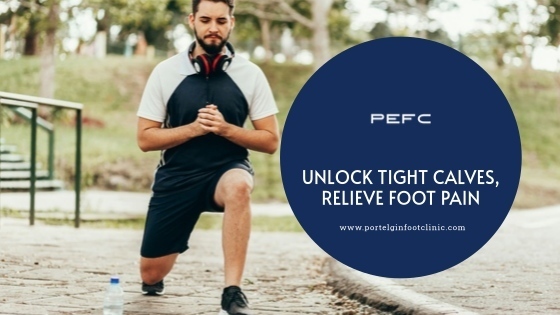
Ease Your Calves, Heal Your Feet!
The calf muscles are crucial for mobility, balance, and stability in our lower body. They play an important role in how we walk, stand, and move, but they’re also prone to tightness and strain. In this guide, we’ll not only cover effective calf exercises but also explore why your calves may feel tight in the first place because ... Tight Calves = Tough Walk.
Why Do Calf Muscles Tighten Up?
There are several reasons why calf muscles can become tight or uncomfortable, which often interferes with your ability to move freely and may even affect treatments like orthotics, injection treatment, or any other means to relieve foot pain.
High Heels and Poor Footwear:
Wearing high heels or shoes with inadequate support shortens your calf muscles over time, making them prone to stiffness and pain. Constant use can disrupt your gait and cause long-term strain.
Lack of Stretching or Exercise:
When your calves aren’t stretched or exercised regularly, they can become tight, especially after prolonged sitting. Muscles that aren't frequently stretched lose elasticity, contributing to stiffness.
Overuse or Muscle Fatigue:
Overworking the calf muscles during high-impact activities, like running or sports, can lead to muscle fatigue and tightness. This often happens when you don’t allow enough time for rest and recovery.
Rheumatologic Conditions:
Autoimmune conditions such as rheumatoid arthritis can lead to chronic inflammation, causing stiffness in joints and muscles, including the calves.
Postural Problems and Gait Issues:
Improper gait or posture can strain your calves as they compensate for imbalances, such as flat feet or high arches. If untreated, this can lead to chronic tightness and discomfort.
Dehydration and Electrolyte Imbalance:
Muscles, including the calves, need proper hydration and balanced electrolytes (like potassium and magnesium) to function well. Dehydration often leads to cramps and muscle tightness.
Tight calf muscles can negatively impact your gait, decrease circulation, and cause pain. They may also make treatments like orthotics less effective because of the disrupted biomechanics in your legs. Therefore, maintaining calf muscle flexibility and strength is key to overall leg health.
Calf muscles are crucial for mobility and stability in our lower body. Strengthening these muscles can help improve overall leg strength and prevent injuries.
Barefoot or In Shoes: What's Best for Calf Stretches?
Whether you stretch your calves barefoot or in shoes can depend on the surface you're standing on and your foot structure. In general, doing calf stretches in supportive footwear is a safer option for most people—especially if you’re stretching on hard surfaces, have foot conditions (like flat feet or high arches), or wear orthotics. Supportive shoes provide cushioning, reduce stress on the heel and arch, and help maintain balance. Barefoot stretching can be beneficial if done on a soft surface like a yoga mat, and may help activate small stabilizing muscles in the feet. However, it's important to listen to your body—if barefoot stretching feels uncomfortable or unstable, stick with shoes. The key is to feel supported and steady while you stretch.
Basic Calf Raises to prevent/relieve calf tightness
1. Standing Calf Raises:
How: Stand with feet hip-width apart, and keep your back straight. Rise onto your toes, lifting your heels as high as possible.
Reps: Aim for 3 sets of 15-20 reps.
2. Seated Calf Raises:
How: Sit on a chair or bench with feet flat on the floor. Lift your heels off the ground as high as possible.
Reps: Perform 3 sets of 15-20 reps.
Advanced Variations
1. Single-Leg Calf Raises:
How: Stand on one foot, and lift the other off the ground. Focus on balance and control.
Reps: Aim for 3 sets of 10-15 reps per leg.
2. Calf Raises on an Incline:
How: Stand on an elevated surface with the balls of your feet on the edge. Always use a railing or wall for balance.
Reps: Perform 3 sets of 12-15 reps.
Tips for Safety and Effectiveness
Proper Form: Maintain control throughout the exercise to avoid strain.
Gradual Progression: Start with fewer reps or sets and gradually increase as your strength improves.
Rest and Recovery: Allow your muscles to rest between sessions for optimal recovery.
Benefits of Calf Exercises
Strengthens Muscles: Builds endurance and strength in calf muscles.
Improves Stability: Helps in balance and stability during movements.
Prevents Injury: Strengthens the lower leg, reducing the risk of strains and injuries.
When to Seek Help
If you experience severe pain during exercises or notice swelling or unusual discomfort in your calves after exercising. Always warm up before starting exercises and cool down afterward. Remember, consistency is key to seeing improvements in muscle strength and endurance.
By understanding what causes tight calf muscles and incorporating these exercises into your routine, you can maintain flexibility, prevent discomfort, and improve overall health.
"Ease Your Calves, Heal Your Feet"
— Jaffer Shaikh DCh, MBBS






